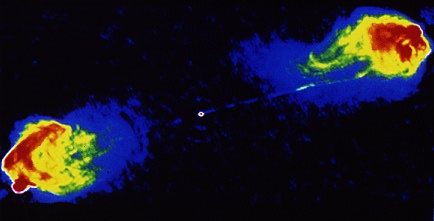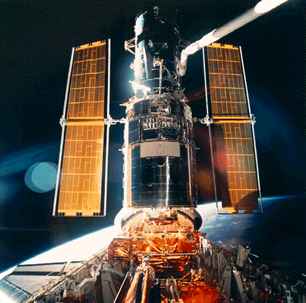
During the second world war many advances in radar technology had been made, and as soon as the war ended British and Australian scientists could use the improved technology to open new windows to the universe. What they found was staggering! Astronomers had for centuries viewed a peaceful universe where stars sail across silent skies and live out their lives in relative peace. When viewed with the new radio-observatories the universe looked rather different.
Exploding galaxies, rapidly varying radio galaxies, quasars, cosmic microwave radiation from the ``big bang'' explosion that formed the universe, flaring X-ray stars - all these and other observational discoveries taught us how violent and strange the universe can be.(Kip Thorne 1974)
By 1950 several dozen discrete radio sources had been detected, but only one (Andromeda) had been identified as a galaxy. The other sources were believed to be dark objects, some kind of radio stars within the Milky Way. If they were extragalactical these sources had to be many times stronger than Andromeda. This seemed impossible, but the consensus would soon change. In October 1951 the Cambridge astronomer F. Graham Smith managed to position the radiosource Cygnus A accurately, and in the following year Walter Baade identified it with a faint object that he interpreted as two colliding galaxies. This was a landmark discovery. Not only did Baade provide evidence that the source was extragalactical, he also suggested a mechanism whereby strong radio waves would be produced. Subsequent observations led to the discovery of many similar sources.

A radio image of Cygnus A shows twin radio lobes stretching 160,000 light years from the centre. Consisting of beams of electrons travelling at near the speed of light, the jets travel tens or even hundreds of thousands of light years, slam into the intergalactic medium and spread out to form radio lobes.
An outstanding example is M87, a strong radio source that has been identified with an elliptical galaxy about 50 million light years away. Matter is ejected at relativistic speed from the centre of this galaxy in two gigantic jets that extend for 2600 light years from the core. The energy radiated through the jets is equivalent to that released in something like 10 million supernova explosions! What central engine could lead to the release of such awesome power? The explanation that caught on was the idea that the AGNs are the manifestation of gigantic black holes located at the heart of distant galaxies. In a paper that appeared in Nature on March 16 1961, Hoyle and Fowler suggested that the radiated energy ought to signal the collapse of some kind of superstar.
Our present opinion is that only through the contraction of a mass of 10-100 million solar-masses to the relativity limit can the energies of the strongest sources be obtained. (Hoyle and Fowler 1961)
This was an intriguing proposal, but it was difficult to see how collapse could be the explanation for the observed jets. The gravitational collapse of even such an enormous congregation of matter would only last a day or so, but the jets were evidence of ongoing emission for more than a million years! Whatever the central object was, it must be able to radiate continually for a very long time. Realizing this, Ya B Zeldovich and Igor Novikov envisaged a model based on a some kind of supermassive compact object powered by accretion. They argued that the mass of such an object must be of the order of 100 million solar masses if the luminosity is to be smaller that the Eddington limit (at which radiation pressure balances the pull of gravitation and thus prevents further accretion). Within this model even the strongest observed sources could be fuelled by accretion of just a few solar masses worth of material per year. The idea seemed plausible and a few years later (in 1969) Donald Lynden-Bell suggested that the central object in an active galaxy is a supermassive black hole feeding off of an accretion disk.
It is now generally believed that most galaxies (including our own) harbour supermassive black holes in their cores. The evidence for this continues to improve as astronomers continue to gather remarkable data on AGN. For example, material have been recorded to travel at around ten times the speed of light in the jets of the quasar 3C273. This speed is, of course, likely to be an illusion caused by the fact that the jet is pointed directly towards us. Nevertheless, it shows that the central engines of these remarkable sources can accelerate the ejected matter to within a fraction of the speed of light. That the central object of the AGNs must be very compact is clear from the short timescale luminosity variations detected by very long baseline radio interferometry. These objects must be tiny compared to the size of galaxies.
 |
In May 1994 NASA announced that the Hubble Space Telescope (left) had ``seen'' a black hole at the centre of M87 (right). The gas in the heart of M87 had been found to whirl rapidly around the very centre of the galaxy. From the observations one could deduce that the centre of M87 must hide an unseen mass of 2.4 billion solar masses. |
|
Another amazing case for a supermassive black hole in a galaxy core was presented in a paper that appeared in Nature on January 12 1995. Miyoshi and collaborators had used the Very Long Baseline Array to monitor the emission lines of water masers (the microwave equivalent of lasers), a new and powerful black-hole probe, and accurately map the gas motion in the spiral galaxy NGC 4258. The observations reveal a disk surrounding a compact dark mass, and the associated rotational velocities follow an almost exact Keplerian law. The mass of the central object was inferred to be 36 million solar masses located inside a radius of 0.13 parsec. The maser observations make a very strong case for a black hole.
The violent activity of many distant galaxy cores inevitably draws our attention to the centre of the Milky Way. Since 1974 it has been known that an unusual radio source is located at the dynamical centre of our galaxy. This source, Sgr A*, is spectacularly tiny and has long been regarded the prime candidate for a supermassive black hole in our galaxy. The mere presence of a unique object very close to the centre of our galaxy is intriguing, but is Sgr A* a black hole? Well, Sgr A* is extremely compact and outshines all other radiosources in the galaxy by many orders of magnitude. On the other hand, it is feeble compared to the average AGN. After many years of speculation the centre of the Milky Way has recently emerged as perhaps the strongest black-hole candidate of all. The evidence is based on remarkable infrared observations by Eckart and Genzel that trace the proper motions of stars near the galactic centre over many years. The detected speeds are consistent with a black hole of mass 2.4 million solar masses inside the central 0.015 pc of the galaxy.